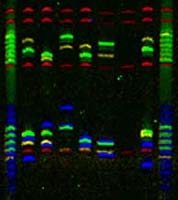Standard improves tests of male DNA

Columns of a DNA gel show the sizes of Y chromosome fragments from 6 male and 1 female sample (empty lane third from right).
Mother Goose tells us that boys are made of “snips and snails and puppy dog tails.” She was clearly misinformed about the snails and tails, but she was on to something with the snips. What you really need to build a boy is a “Y” chromosome, and it turns out that SNPs (single nucleotide polymorphisms), known by the biotech cognoscente as simply “snips,” can be helpful in sorting out who fathered the boy. If DNA can be thought of as an instruction book for building a specific person, then SNPs are single letters at an exact location in that book that tend to vary among individuals.
A new Standard Reference Material (SRM) issued by the National Institute of Standards and Technology (NIST) uses both SNPs and STRs (sections where three to five DNA “letters” form repeating patterns) to help improve the reliability of laboratory analyses of male DNA. The result of several years of research, the standard consists of six vials of very carefully analyzed DNA. Five are male samples, and one is female. Laboratories that perform forensics or paternity DNA analyses can use the SRM to double check the accuracy of their equipment and test procedures for analyzing the Y chromosome. It also may be helpful for population studies that study whether the human race evolved from one or many “Adams.”
Each vial comes with certified DNA sequences for 22 different STR locations and 42 different SNPs. NIST research chemist Margaret Kline provided a detailed description of the SRM and the methods used in preparing it at the 14th International Symposium on Human Identification in Phoenix, Ariz., on Oct. 1, 2003.
Media Contact
More Information:
http://www.nist.gov/All latest news from the category: Life Sciences and Chemistry
Articles and reports from the Life Sciences and chemistry area deal with applied and basic research into modern biology, chemistry and human medicine.
Valuable information can be found on a range of life sciences fields including bacteriology, biochemistry, bionics, bioinformatics, biophysics, biotechnology, genetics, geobotany, human biology, marine biology, microbiology, molecular biology, cellular biology, zoology, bioinorganic chemistry, microchemistry and environmental chemistry.
Newest articles

Bringing bio-inspired robots to life
Nebraska researcher Eric Markvicka gets NSF CAREER Award to pursue manufacture of novel materials for soft robotics and stretchable electronics. Engineers are increasingly eager to develop robots that mimic the…

Bella moths use poison to attract mates
Scientists are closer to finding out how. Pyrrolizidine alkaloids are as bitter and toxic as they are hard to pronounce. They’re produced by several different types of plants and are…

AI tool creates ‘synthetic’ images of cells
…for enhanced microscopy analysis. Observing individual cells through microscopes can reveal a range of important cell biological phenomena that frequently play a role in human diseases, but the process of…





















